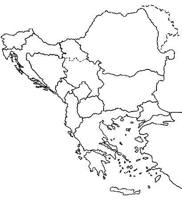
|
The Society of Folk Dance Historians (SFDH)
Kolo Lines
[
Home |
About |
Encyclopedia | CLICK AN IMAGE TO ENLARGE |

|
The time to write an article: When the teacher announces "the kolo for this evening will be Never on Sunday . . . and when the festival program lists "Two kolos: Karagouna and Ahavat Hadasah."
 Perhaps a definition of the name "kolo" is in order. Perchance we failed in this years ago, but then there was no cause for caution in the usage of the word because "line dances" were kolos. Greek and other Balkan and Near Eastern dances were introduced as dances of those countries and the aficionados then knew the difference. And, of course, the Israeli dance movement came into popularity on its own, and without relationship to, or help from, the kolo world. But now, a decade later, the new people coming into our dance world, as well as the seasoned folk dancer coming into contact with "kolos," cannot see the difference, nor the need to differentiate. Hence, folk dancers are learning "kolos" like Misirlou, and one's favorite might well be Mayim.
Perhaps a definition of the name "kolo" is in order. Perchance we failed in this years ago, but then there was no cause for caution in the usage of the word because "line dances" were kolos. Greek and other Balkan and Near Eastern dances were introduced as dances of those countries and the aficionados then knew the difference. And, of course, the Israeli dance movement came into popularity on its own, and without relationship to, or help from, the kolo world. But now, a decade later, the new people coming into our dance world, as well as the seasoned folk dancer coming into contact with "kolos," cannot see the difference, nor the need to differentiate. Hence, folk dancers are learning "kolos" like Misirlou, and one's favorite might well be Mayim.
What is a "kolo?" We have led and been led into understanding that a kolo is a circle dance, broken or complete, no partners, joined hands held low, leader at the right end, etc. This is very true. But it is also generally very true of dances of the smae type which are not kolos. And you can hardly tell the difference by looking. The key is in the origin: it must be Yugoslav; every kolo is a Yugoslav kolo. You sort of have to prefix the kolo title with the country name, such as Yugolsav Nebesko kolo. Of course, if you do not know that Misirlou is not one of these, this will not help much. And then, just any dance from Yugoslavia is not necessarily a kolo. There is a second geographical requirement; kolos come form areas inhabited by the Serbians and Croatians. We know that the Slovenians enjoy Austrian-like couple dances and the Macedonians refer to their kolo-like dances as "oro."
The word "kolo" means "wheel." The plural form is "Kola," but here we have Americanized it, and correctly so, to "kolos." Pronounce it KOH-loh, not KOE-low or KOE-lah. Curiously, the Yugoslav choreographers, writers, and researchers group all of the dances from the Serbian-Croatian kolo country as "narodna kola" (national dances or kolos) even if they are done in couple position, for which style they prefer to use the word "par" ("pair"), instead of the circular formation. Hence, Keleruj is a kolo, though not a "line dance."
It would be convenient to be able to say that kolos are played only by tamburica orchestras, but we cannot. The tamburica is used almost exclusively in the Croatia-Slavonia-Vojvodina area and many of our perennial favorites such as Seljančica, Nebesko kolo, Zaplet, and Malo kolo are popular perhaps because of the tamburica sounds. Dances of Serbia proper, however, today use more conventional orchestra instruments, chiefly clarinet and accordion, plus the native frula (wooden flute). In the Unites States, tamburica orchestras often invade other areas for dance music, but you can certainly tell the difference! When the writer asked the "KOLO" orchestra leader if he would prefer to use the tamburica orchestra to play "Žikino kolo" (which, after all, is today sort of half and half, in the United States at least), he said, "Ne daj Bože!" (God forbid!).
It might be easier to define what a kolo is not, or what is not a kolo. Again, geographically, if the dance comes from Bulgaria, Macedonia, Romania, Greece, Turkey, Armenia, Israel, or any country other than Yugoslavia, you can bet your last cent it is not a kolo. Those are dances of those countries and they have merited a right to stand alone, and should so be credited. The people of the Balkan and Near Eastern countries, because of their ancient histories and traditions, dance in the peculiar line or circular formation; central and northern Europeans have learned to like dancing in couples. The latter named their dance form by the steps (Polka, Ländler, Mazurka, etc.) and these steps are generally used by all the countries with little exclusive national feeling while the Balkan and Near Eastern countries used the formation in naming their "national dance." Hence, we have: "kolo" (wheel) in Yugoslavia, "oro" (Macedonia), "horo" (Bulgaria), "hora" (Romania), "horos" (Greece) – all derived from the ancient Greek "choros" both in word and formation – "bar" (Armenia), and "hora" also Jewish and Israeli from the same source.
It stands to reason, then, that those dance terms are not interchangeable, and any one can be used only with the dances, or some of them, of that particular country, even if they all look like kolos (which they are NOT!).
DOCUMENTS
- Ivan "John" Filcich, an article.
- Kolo (The), an article.
- Kolo: Some Background, an article.
- Kolo Festival, an article.
Used with permission of the author.
Printed in Let's Dance!, November 1978.
This page © 2018 by Ron Houston.
Please do not copy any part of this page without including this copyright notice.
Please do not copy small portions out of context.
Please do not copy large portions without permission from Ron Houston.